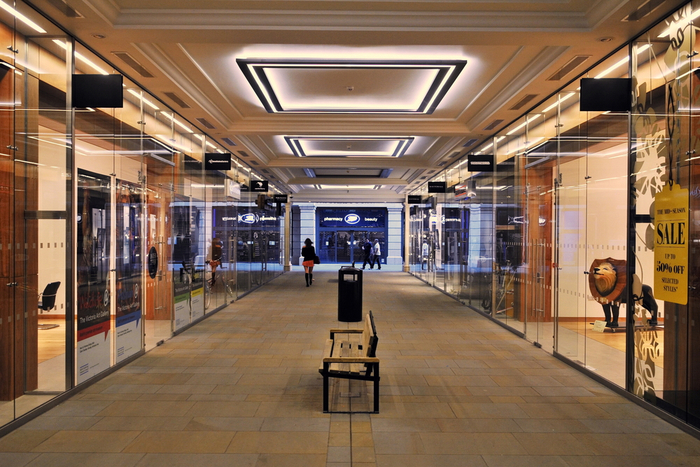What is going to happen to the UK’s unviable shopping centres? That’s a million-pound question plaguing many retailers and real estate developers.
Shopping centres have long provided convenience for consumers by locating shops in a sphere-like environment where people can access them easily. Typically encompassing large spaces and enclosed rooftops, shopping centres are often located near public transport routes and motorway junctions, and also offer car parks.
While the Covid-19 pandemic has affected trading in all retail destinations, including high streets and retail parks, shopping centres appear to have been hit the hardest.
As current government restrictions in the UK dictate that consumers must wear a face covering in indoor spaces, and with the Covid virus being more transmissible indoors, shopping centres have arguably become a less desirable place for shopping.

According to the latest BRC-Sensormatic Footfall Monitor, shopping centre footfall declined by 41.3 per cent in May compared with a high street decline of 34.6 per cent.
Meanwhile, Local Data Company’s analysis of centres in England, Scotland and Wales found that up to 70 shopping centres across the UK could be forced to close due to the effects of the Covid-19 pandemic.
At least 30 shopping centres in the UK are now at least half empty including five with more than 80 per cent of their shops vacant following months of lockdowns.
A further 34 centred have between 40 per cent and 50 per cent of their units vacant, which equates to at least 10 shops.

Knight Frank head of retail research Stephen Springham said 10 per cent of shopping centres were no longer viable. He believes a further 20 per cent to 30 per cent – about 200 shopping centres – will need a significant overhaul, such as converting parts of the centre into residential, offices or other uses.
Undoubtedly, online shopping as well as the over-expansion of retail space has threatened 70 out of the UK’s 700 or so shopping centres.
The demise of major anchor stores like BHS and Debenhams in the last couple of years has also also led to their decline, and this was only exacerbated by the various lockdowns and tiered restrictions the country endured since March last year.

In June last year, Intu Group fell into administration after crunch talks with its lenders were unsuccessful. With a portfolio of 14 wholly-owned centres and three joint ventures, Intu was the UK’s largest shopping centre owners at the time of its collapse.
Meanwhile, shopping centres such as Westfield have been taking a different approach and adding exhibition space where they can do big product launches. For example, Westfield London recently announced it would launch a new “interactive” pop-up shopping experience on June 24 in an effort to engage directly with a new audience.
The new pop-up will aim to push the boundaries of sustainability, trailblaze new production methods and integrated technology in all areas of the business, and showcase brands across fashion, beauty, and lifestyle.
In today’s climate, it’s no surprise that shopping centres are struggling. Due to high business rates, retail tenants are increasingly investing in online offerings for customers – also to meet rising demand for online shopping. The shops likely to survive are those with a strong offline proposition.
“As ecommerce became a larger force, department stores in particular – those anchor stores that theoretically drive traffic – have struggled,” said Nikki Baird, vice president of retail innovation at tech provider Aptos.
“When shopping centres pulled back on events and advertising and on creating a sense of community at the same time, the situation became what could have been a death spiral for them.
“Newer centres and places where there was significant reinvestment have tried to address some of those shortcomings, but they have mostly addressed it by investing in the opening of other types of retail that drive traffic – cinemas, fitness centres, grocery stores, or restaurants – or building housing alongside so that the space is more mixed-use.”
Payal Hindocha, director of customer engagement platform Emarsys, told Retail Gazette that the recent closure of some major stores that pull the crowds, like John Lewis, Debenhams and Topshop, has “certainly been tough for other surrounding stores”.
“There’s still plenty of demand from consumers across the board because, despite the name, a shopping centre has more to offer than just shopping,” she said.
“Home to restaurants, cinemas, gaming arcades and more, shopping centres are a place where everyone can meet, socialise, and enjoy spending time.
“Retail as an industry has become more experiential – and retailers need to capitalise on this opportunity.
“It is likely that there are still some consumers who remain anxious about visiting a shopping centre even following the easing of lockdown restrictions, due to the enclosed environment.
“Retailers in shopping centres will therefore have to be mindful of people’s concerns and ensure they take them on board, adapting the in-store experience to be as safe and attractive as possible.”
Retail expert Nelson Blackley argued that shopping centres were slowly dying out in their existing form.
“Shopping centres are worth saving – but not in the huge numbers”
“All those that have relied on mid-market fashion brands and tired department stores as tenants are struggling, given that the Arcadia Group and Debenhams no longer have physical stores,” he said.
“The demise of these two retail groups earlier this year has left gaping holes in shopping centres across the UK which has been compounded to by the continued closures of John Lewis and Marks & Spencer stores in selected locations.”
Blackley added that in November 2018 – well before the pandemic – 200 of the worst performing shopping centres across the UK were “in crisis” and were at threat of closing down.
“The challenges of the past 15 months during successive lockdowns for ‘non-essential’ retail (like so many other business trends) has simply accelerated this,” he said.
“Most UK covered shopping centres have relied on national retail brands to occupy their store space.
“High streets have also been guilty of attracting the same ‘clone town’ list of familiar retail brands, but at least they have always also had some other independent and local retailers and of course food retailers.
“Only around 15 per cent of shopping centre retail tenants were classified as ‘essential’ in the lockdowns in 2020 and 2021 and so these retail locations have been disproportionately disadvantaged in shopper footfall since March last year.”
Blackley said that despite their challenges, shopping centres are worth saving – “but not in the huge numbers that have appeared over the past 50 years”.
“Some will continue to be successful; others will evolve in different ways to continue operating but there will be others that are unable to survive and will close,” he added.
“Retail existed for centuries until the first shopping centres were built in the UK in the 1960s and retail will no doubt survive in some form for centuries to come, whether shopping centres are part of the landscape or not.”
Undoubtedly, the inherent convenience that shopping centres provide could be the primary reason that they continue to maintain a level of relevance in the retail sector. Meanwhile, the appeal of retail parks continues to lie in the ability to visit large-capacity venues – arguably presenting a great threat to shopping centres.
Traditionally, retail parks have been an attractive option due to their accessibility and convenience, but retailers within retail parks are no different to the wider sector in that they must continue to innovate and adapt to bring in new customers.
Today’s shoppers want a well-rounded experience and shopping centres provide this: they offer amenities, immersive surroundings and entertainment to enhance the shopping experience. They are not only anchored by department stores but also with restaurants, bars, salons, cinemas, and gyms too.
Shopping centre owners need to reconfigure their centres for the post-Covid reality in which won’t just involve retail, but a wider mix of activities to attract consumers.
Click here to sign up to Retail Gazette’s free daily email newsletter

















